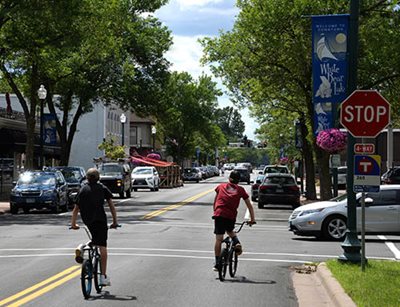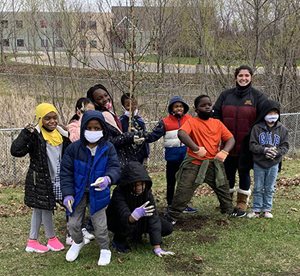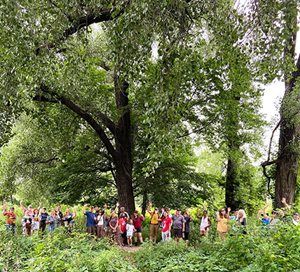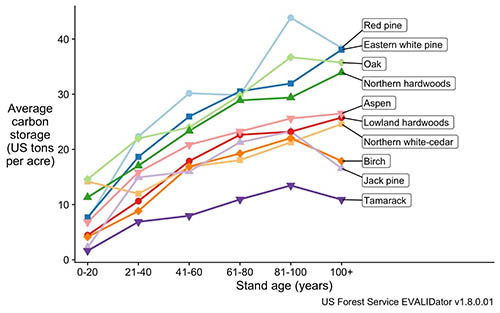 Trees give us many gifts: abundant oxygen, carbon storage, cooler temperatures, better air quality, great beauty, and more. They are key to human survival and thriving. Enhancing and preserving our tree canopy helps to create healthy and resilient places to live.
Trees give us many gifts: abundant oxygen, carbon storage, cooler temperatures, better air quality, great beauty, and more. They are key to human survival and thriving. Enhancing and preserving our tree canopy helps to create healthy and resilient places to live.
Our region faces complex and interconnected challenges, and trees have a role in addressing many of them. For example, climate change-related hazards — such as extreme heat — disproportionately affect vulnerable residents living in areas of historic disinvestment, including formerly redlined neighborhoods. Serving our communities better requires a targeted, intersectional, and equitable approach to tree canopy management.
The Metropolitan Council, in partnership with The Nature Conservancy and Tree Trust, has developed an application called Growing Shade. The project combines local stories with an interactive mapping tool to help foresters, planners, advocacy groups, and others make decisions about preserving and enhancing our tree canopy.

“Changing the game” on tree canopy management
The mapping tool allows users to generate reports based on variables like climate change, conservation, environmental justice, and public health at a range of scales from census block groups to townships-cities. Users can choose and combine variables to generate data to meet their specific needs, such as setting tree canopy goals for a community or producing supporting data for grant applications.
“This is going to change the game on tree canopy planning at the local level,” said Met Council Chair Charlie Zelle. “The stories within this new tool educate and inform by highlighting ground-level action to enhance and preserve tree canopy. The tool is cutting-edge because it provides data-driven reports, is fully customizable, and includes up-to-date information that is critical in making and enacting plans for a more sustainable and equitable region.”
Local stories show how racism, land use decisions impact communities
When cities make land use decisions, everyone is impacted — some more positively than others.
“When infrastructure is prioritized over community life, such as the decision to build Interstate 94 through the heart of the vibrant African American Rondo neighborhood, the impacts last generations,” explained Eric Wojchik, Met Council planner. “It was important for our new tool to consider our region’s specific history in a focused way which is often missed in more generalized, national-level analyses.”
 In addition to the economic and cultural devastation of decisions like I-94, there is increased air pollution from traffic, loss of tree cover, and an increase of paved surfaces, which raises ground temperatures. This adds to the already disproportionate health challenges that Black, Indigenous, and people of color typically face.
In addition to the economic and cultural devastation of decisions like I-94, there is increased air pollution from traffic, loss of tree cover, and an increase of paved surfaces, which raises ground temperatures. This adds to the already disproportionate health challenges that Black, Indigenous, and people of color typically face.
Some of the stories in Growing Shade lift up the voices of communities who have often been left out of decisions that impact their well-being. Each one highlights unique considerations for enhancing and preserving the tree canopy. Themes include:
- Equity: Frogtown Green advocates for environmental justice through tree planting.
- Restoration: Lower Phalen Creek Project is healing Dakota culture and land through restoration.
- Preservation: Washington County Conservation District works to preserve and restore forests.
- Education: Brooklyn Center Community schools engage youth in learning and creating greenspace.
- Maintenance: Tree Trust emphasizes the importance of tree care and maintenance.
Trees play a vital role in combatting climate change
Some models of climate change impacts in the Twin Cities region show that we could have as many as 40 additional days above 90 degrees each year by 2050. Tree inequity creates hotter neighborhoods, and an increase in premature deaths due to heat impacts.
And while planting more trees is important, conserving more mature trees offers the largest benefits. “Large trees provide more shade, store more carbon, and produce bigger benefits in terms of air and water quality,” said Ellen Esch, Met Council data scientist. “It may be that using insecticide treatments to combat emerald ash borer is the best strategy in some urban neighborhoods.”

Engaging local residents is key to successful efforts
While Growing Shade is a powerful tool for planning for tree canopy management, the most successful strategies will always involve engagement of local residents, Esch said. Top-down decisions that ignore local preferences for tree species or local capacity for tree maintenance may not produce the desired results.
Growing Shade built with and for partners, stakeholders
Before developing Growing Shade, project partners surveyed forestry practitioners to learn about their goals as they manage the region’s tree canopy. The partners formed an advisory group to help shape and create the tool.
“Now more than ever, we need to bridge the gap between advocacy, planning, and science to address needs,” Esch said. “In future, all tools would benefit from an approach like this, which truly responds to emerging needs from forestry professionals, government staff, and tree canopy advocates. The challenges we face are interconnected and complex, and they require us to work in innovative, collaborative ways.”
Additional stakeholders were engaged in testing a draft version of the tool before Growing Shade was launched to the public in late January. The tool will be updated regularly with the most current data available.
Upcoming opportunities to learn more about the tool
More information